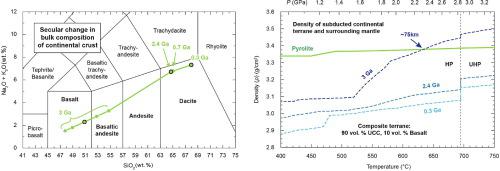Geoscience Frontiers ( IF 8.9 ) Pub Date : 2021-05-09 , DOI: 10.1016/j.gsf.2021.101225 Richard M. Palin , James D.P. Moore , Zeming Zhang , Guangyu Huang , Jon Wade , Brendan Dyck

|
The absence of ultrahigh pressure (UHP) orogenic eclogite in the geological record older than c. 0.6 Ga is problematic for evidence of subduction having begun on Earth during the Archean (4.0–2.5 Ga). Many eclogites in Phanerozoic and Proterozoic terranes occur as mafic boudins encased within low-density felsic crust, which provides positive buoyancy during subduction; however, recent geochemical proxy analysis shows that Archean continental crust was more mafic than previously thought, having greater proportions of basalt and komatiite than modern-day continents. Here, we show via petrological modelling that secular change in the petrology and bulk composition of upper continental crust would make Archean continental terranes negatively buoyant in the mantle before reaching UHP conditions. Subducted or delaminated Archean continental crust passes a point of no return during metamorphism in the mantle prior to the stabilization of coesite, while Proterozoic and Phanerozoic terranes remain positively buoyant at these depths. UHP orogenic eclogite may thus readily have formed on the Archean Earth, but could not have been exhumed, weakening arguments for a Neoproterozoic onset of subduction and plate tectonics. Further, isostatic balance calculations for more mafic Archean continents indicate that the early Earth was covered by a global ocean over 1 km deep, corroborating independent isotopic evidence for large-scale emergence of the continents no earlier than c. 3 Ga. Our findings thus weaken arguments that early life on Earth likely emerged in shallow subaerial ponds, and instead support hypotheses involving development at hydrothermal vents in the deep ocean.
中文翻译:

镁铁质太古宙大陆壳禁止造山带超高压榴辉岩的发掘
地质记录中早于c的超高压(UHP)造山榴辉岩不存在。对于在太古代(4.0–2.5 Ga)期间地球上已发生俯冲的证据,0.6 Ga存在问题。镁铁质布丁包裹在低密度的长英质地壳中,在古生代和元古代的地层中发生了许多榴辉岩,在俯冲过程中提供了正浮力。但是,最近的地球化学代理分析表明,太古代的陆壳比以前想象的要黑铁质,玄武岩和科马蒂岩的比例比现代大陆要大。在这里,我们通过岩石学建模表明,岩石学和上陆壳的整体组成的长期变化将使太古宙大陆地幔在达到超高压条件之前在地幔中呈负浮力。俯冲或分层的太古宙大陆壳在变质过程中,在中山岩稳定之前就没有返回点,而元古生代和生代生代地壳在这些深度仍保持正浮力。因此,UHP造山榴辉岩可能很容易在太古宙地球上形成,但尚未被挖掘出来,从而削弱了对新元古代俯冲和板块构造发生的论据。此外,对较镁铁质的太古代大陆进行的等静平衡计算表明,早期地球被深达1公里的全球海洋所覆盖,这为最早出现在c之前的大陆大规模出现提供了独立的同位素证据。3 Ga。我们的发现因此削弱了这样的论点,即地球上的早期生命可能出现在浅层的地下池塘中,



























 京公网安备 11010802027423号
京公网安备 11010802027423号